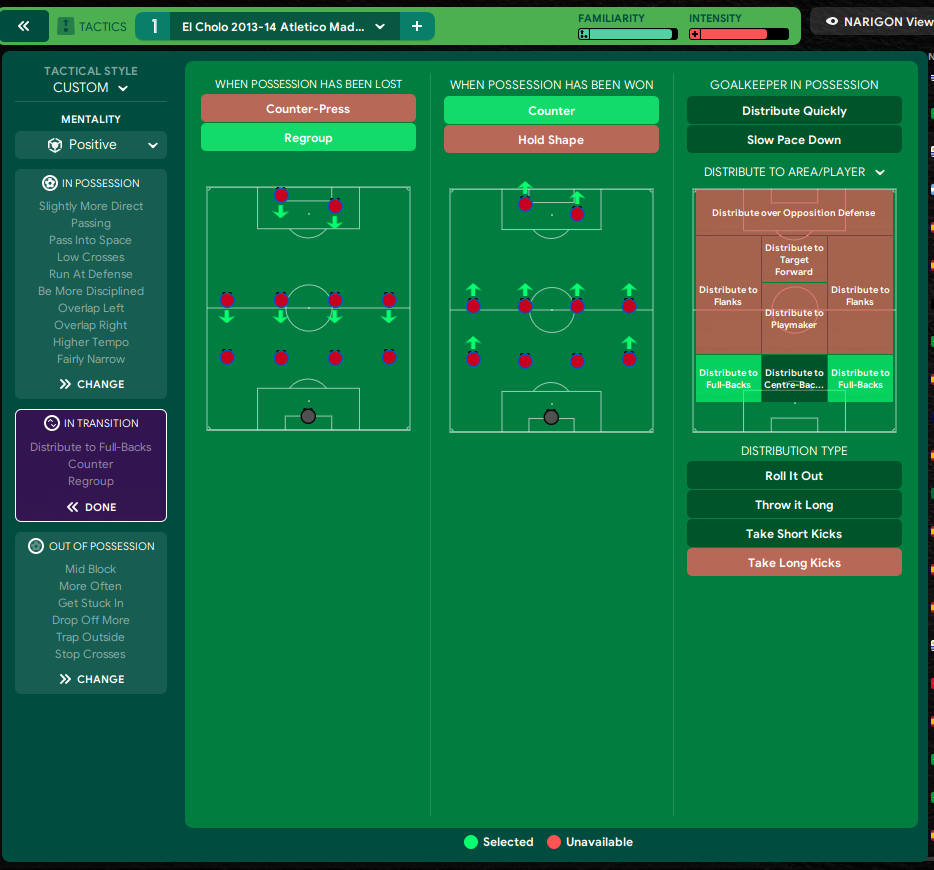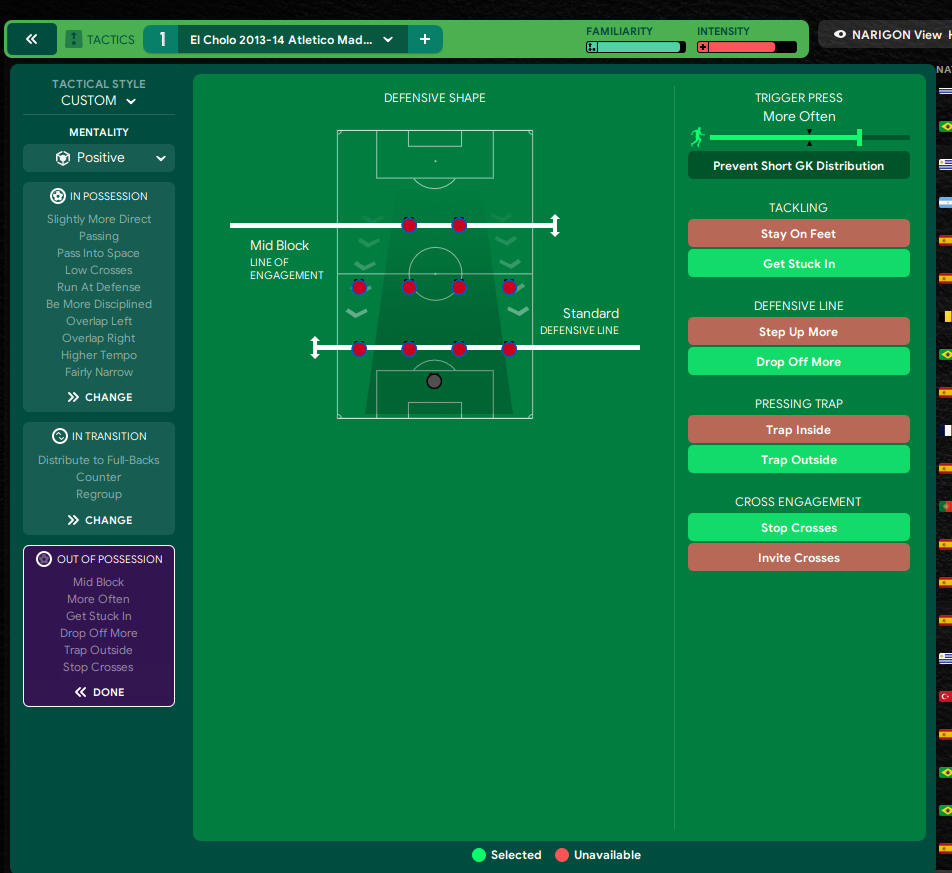| Tester | Team | ME | Win % | PPG | AGF | AGA | GD | PL | W | D | L | |
|---|---|---|---|---|---|---|---|---|---|---|---|---|
| Deleted User #1866315 |
 Atlético
Atlético
|
24.3.0 | 89% | 2.79 | 3.5 | 0.9 | 2.61 | 38 | 34 | 4 | 0 |
ATLETICO MADRID 2013-2014: CHOLISMO
Diego Simeone's "Cholismo" is characterized by relentless pressing, rapid vertical counterattacks, and a raw, pragmatic approach to football. This distinctive style starkly contrasts with the aesthetically pleasing football pursued by Europe's top clubs, focusing solely on the ultimate goal: victory.
Early Coaching Career
After an illustrious playing career in Argentina (Velez and Racing Club), Spain (Sevilla and Atletico Madrid), and Italy (Pisa, Inter, and Lazio), where he collected numerous titles including a Spanish championship (1996), an Italian championship (2000), and several cups, Simeone began his coaching journey with Racing Club in Argentina. His teams mirrored his playing style: aggressive, resilient, and unyielding. His tenacious philosophy quickly bore fruit, leading Estudiantes to a historic championship win in 2006 and guiding River Plate to victory in the 2008 Clausura.
Despite a challenging tenure at River Plate and a brief stint at San Lorenzo, Simeone accepted an offer from Catania in Italy, joining a club with a strong Argentine presence. Despite a rocky start, he led Catania to a respectable 13th place finish, setting a club record with 46 points and ensuring their survival in Serie A.
Return to Racing and Breakthrough at Atletico Madrid
Simeone returned to Racing, driving them to a second-place finish in the Apertura. However, internal conflicts led to his departure in December 2011. Shortly thereafter, he took over Atletico Madrid, revitalizing the team and propelling them to a 5th place finish and an emphatic Europa League triumph.
At Atletico, Simeone found his ideal environment, free from conflicts with the management. His players bought into his vision, embodying a hardworking spirit that laid the foundation for one of Europe’s strongest teams. Under his leadership, Atletico won the European Super Cup and the Copa del Rey, finishing third in La Liga, just behind Real Madrid and Barcelona, and securing a Champions League spot.
Champions League and La Liga Triumph
The 2013/2014 season saw Atletico clinch the La Liga title and narrowly miss out on the Champions League trophy, losing to Real Madrid in extra time. Despite key player departures in the following season, Atletico maintained a high standard, reaching the Champions League quarterfinals and finishing third in La Liga. The emergence of Antoine Griezmann signaled a new era of success.
Recent Developments
The 2015/2016 season has been one of Atletico's finest. Key signings like Jackson Martinez, Ferreira Carrasco, and the return of Filipe Luis bolstered the squad. Simeone’s preferred 4-4-2 formation, emphasizing rapid counterattacks and a formidable defensive structure, proved highly effective. Players like Saul Niguez, Jan Oblak, and Griezmann flourished under his demanding regimen.
Simeone's tactical discipline has ingrained a rigorous defensive mindset within the team, with every player contributing to this ethos. This collective effort has been pivotal in Atletico's recent achievements, including their impressive performances in the Champions League.
Conclusion
Atletico Madrid stands on the brink of history once again, facing Real Madrid in the Champions League final. Much of the credit goes to their charismatic leader, Diego Simeone, whose "Cholismo" philosophy has forged a team capable of overcoming even the most illustrious opponents with sheer determination and heart.
HOW TO EMULATE THIS TACTIC IN FOOTBALL MANAGER 2024
To emulate Simeone’s cholismo 4-4-2, we start with a positive mentality that allows our team not to leave too much space to the opponent.
If you are managing an underdog-lower team you can use a balanced mentality.
I did not use a cautious or even defensive mentality because in the out of possession instruction I already selected a mid-block with a standard defensive line which could be even switched to a lower against stronger opponents.
In the possession phase, the attacking width is fairly narrow because Atletico often tries to attack from central areas, considering also the fact that the two wide midfielders Koke and Arda Turan always tuck inside, while only the two wing-backs Juanfran and Filipe Luis provide width when they push forward into the opponent’s half. For this reason, I instructed them to overlap left and right.
About passing style and tempo, Atletico plays a more direct style so I chose a slightly more direct passing style with a higher tempo that is one of cholismo main features. Pass into space is also a very important instruction because it allows our team to exploit the spaces between the opponent’s midfield and defensive lines.
Atletico did not play a possession based game (tikitaka style) when attacking and wingers like Arda Turan were free to try to dribble past their direct opponent in 1vs1 situation, so I selected run into defense. Crosses are low.
Atletico was a very disciplined team tactically so I selected to be more disciplined.
In the transition phase, Atletico did not try gegenpressing , they pressed the opponent at times, not always, so there is no “6 seconds high pressing rule” to apply here. If you want your team to be even more careful in this phase, you can add the instruction regroup, as I did for this tactic, but you can also remove it.
When Atletico win the ball back, they launch fast counterattacks, for this reason the instruction counter is mandatory.
The goalkeeper has the instruction to pass the ball to the wing-backs to build the play because the two central defenders Miranda and Godin had only defensive tasks.
As said before, in the non possession phase, Atletico defended with a mid-block that could even become a low-block in the last minutes of a difficult match where the colchoneros were able to frustrate all opponent’s attempts. The defensive line is standard but as said before, it can be switched to lower too.
Atletico’s tactic mean feature was pressing, but since we use a mid-block, the trigger press is more often, not much more often and I did not select the instruction to prevent gk short distribution because our players don’t press so high. Other instructions are: get stuck in (but feel free to remove it when you see that you are getting too many yellow or red cards), drop off more, trap outside (to use the touchline as an additional defender, this helps to replicate exactly Atletico wide pressing style) and stop crosses.
Player roles and instructions
Gk: Courtouis: simple goal-keeper in defend, nothing to add
RWB: Juanfran: wing-back in attack: tackle harder, close down more, mark tighter.
LWB: Filipe Luis: same of the RWB: wing-back, attack: tackle harder, close down more, mark tighter.
The two wing-backs push forward to the opponent’s half and are the only two players who provide some width, crosses and they help in pressing too, while the two central defenders Miranda and Godin have no pressing tasks.
RCB: Miranda: central defender-defend: tackle harder, close down less (no pressing task to avoid he leaves spaces behind him), take fewer risks
LCB: Diego Godin: same with Miranda.
RM: Koke: wide playmaker-support: tackle harder, mark tighter. He will tuck inside and help build the play, when he does so, he leaves a lot of space on the right flank for Juanfran who will overlap. In defense, Koke will cover Juanfran and also helps him to press in wider areas, creating a 2vs1 situation against the opponent player. He is good with the ball and at passing that’s why I chose for him a wide playmaker role.
LM: Arda Turan: Wide-midfielder-support: cross more often, cut inside with the ball, get further forward, sit narrower (he will tuck inside when Filipe Luis overlaps and pushes forward), mark specific position (he will mark the opponent’s right FB), tackle harder, mark tighter.
Arda Turan had an amazing season in my save, and was the best assistman in La Liga.
RCM: Thiago (or Mario Suarez): BBM-support: close down less, mark tighter, tackle harder. You can remove the close down less option if you want him to press more, I used this because I want him to avoid getting lured away by the opponent and leave space behind him.
LCM: Gabi: DLP-support: no instructions. Gabi is Atletico’s playmaker, he drops deep in defense to help cover spaces and also to build the play.
RCF: Diego Costa: DLF-support: shoot less often (this does not mean he won’t shoot, but he will avoid to shoot when it’s too difficult and he will pass the ball), tackle harder, mark tighter. I wanted to choose a Pressing forward role for him because he has the task to press the opponent’s defense, but after trying it for a couple of matches, I opted for a deep-lying forward because with this role Diego Costa also helps to link the play and passing. To add pressing and defensive tasks, I just needed to add the instruction to mark and tackle harder.
He had a great season scoring 21 goals in 36 games in La Liga, with 12 assists.
LCF: David Villa: advanced forward-attack, no instructions
La Liga topscorer with 51 goals in 38 matches and 6 assists, his only task is to score goals.
With this tactic I won the treble (La Liga with 106 pts, Spanish Cup, Champions League), scored a lot, 132 goals in La Liga (best attack) and allowed only 33 goals (best defense).
Test Results
 Atlético
Atlético
You'll need to Login to comment




